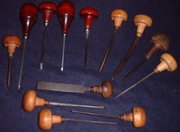Engraving
|
|
Engraving is the practice of incising a design onto a hard, flat surface, by cutting grooves into it. The result may be a decorative object in itself, as when silver or gold are engraved, or may provide an intaglio plate, when copper is engraved, or a relief print block when wood is engraved.
| Contents |
The engraving process
Engravers use a hardened steel tool called a burin to cut the design into the surface, most traditionally a copper plate. Gravers come in a variety of shapes and sizes that yield different line types. The burin produces a unique and recognizable quality of line that is characterized by its steady, deliberate appearance and clean edges. The angle tint tool has a slightly curved tip that is commonly used in printmaking. Florentine liners are flat-bottomed tools with multiple lines incised into them, used to do fill work on larger areas. Flat gravers are used for doing fill work on letters, as well as most musical instrument engraving work. Round gravers are commonly used on silver to create bright cuts, as well as other hard-to-cut metals such as nickel and steel. Burins are either square or elongated diamond-shaped and used for cutting straight lines. Other tools such as mezzotint rockers, roulets and burnishers are used for texturing effects.
LeopoldIBelgium.jpg
History and usage
In antiquity, the only engraving that could be carried out is evident in the shallow grooves found in some jewellery after the beginning of the 1st Millennium B.C. The majority of so-called engraved designs on ancient gold rings or other items were produced by chasing or sometimes a combination of lost-wax casting and chasing.
Before the advent of photography, engraving used to reproduce other forms of art, for example paintings. Engravings continued to be common in newspapers and many books into the early 20th century, as they were long cheaper to mass reproduce than photo images. Engraving has also always been used as a method of original artistic expression.
Because of the high level of microscopic detail that can be achieved by a master engraver, counterfeiting of engraved designs is well-nigh impossible, and modern banknotes are almost always engraved. Many classic postage stamps were engraved, although the practice is now mostly confined to particular countries, and/or used when a more "elegant" design is desired and a limited color range is acceptable.
Modern engraving
All32.jpg
The modern discipline of hand engraving survives largely in a few specialized fields. The highest levels of the art are found on firearms and other metal weaponry, jewelry and musical instruments. In most of industrial uses like production of Intaglio plates for commercial applications hand engraving was replaced with milling using CNC engraving/milling machines.
References
- A. M. Hind (1923, repr. 1963). History of Engraving and Etching. Dover.
- A. Gross (1970). Etching, Engraving, and Intaglio Printing.
- G. Duplessis (1989). Wonders of Engraving.

